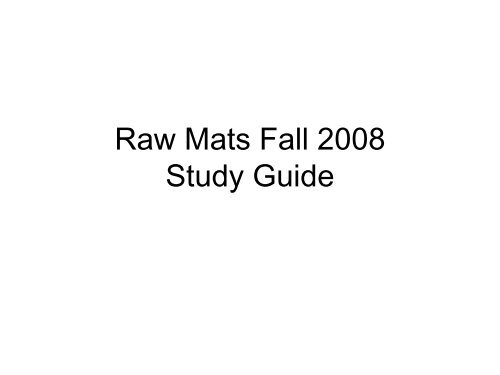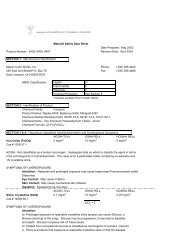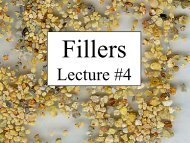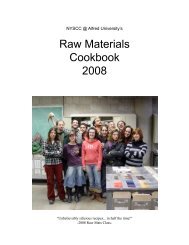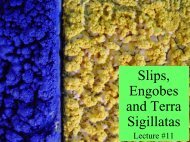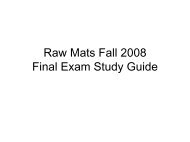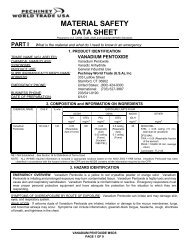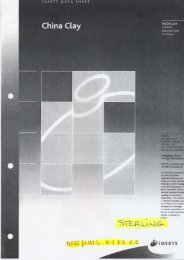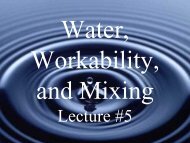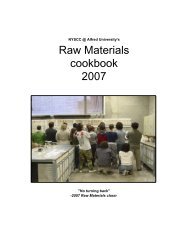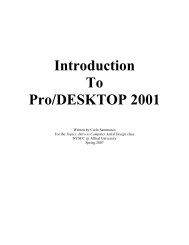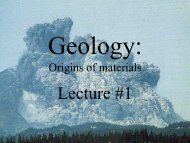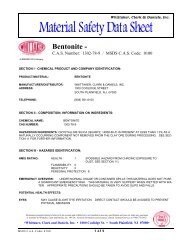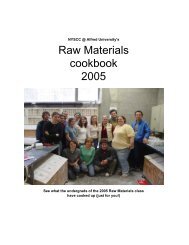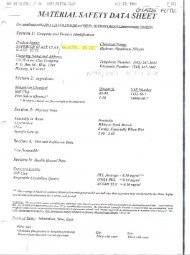Raw Mats Fall 2008 Study Guide - Alfred's Clay Store
Raw Mats Fall 2008 Study Guide - Alfred's Clay Store
Raw Mats Fall 2008 Study Guide - Alfred's Clay Store
Create successful ePaper yourself
Turn your PDF publications into a flip-book with our unique Google optimized e-Paper software.
<strong>Raw</strong> <strong>Mats</strong> <strong>Fall</strong> <strong>2008</strong><br />
<strong>Study</strong> <strong>Guide</strong>
Mid Term<br />
• Next week (Wednesday, October 8 th )<br />
• In class<br />
• Open book<br />
(handwritten notes are fine, but no class<br />
printouts)
<strong>Clay</strong>s<br />
• Kaolinization of feldspar<br />
– The role of water<br />
• Primary / secondary clays<br />
• <strong>Clay</strong> types (kaolin, ball clay, stoneware,<br />
fireclay, earthenware, bentonite)<br />
– Characteristics (plasticity, maturity, composition,<br />
fired characteristics)<br />
– Benefits / disadvantages of each<br />
• <strong>Clay</strong> mineralogy: Kaolinite vs. Montmorillonite<br />
– 1:1 vs. 2:1 layers
Fluxes<br />
• Effects of fluxes after firing<br />
– Density, Strength, Shrinkage<br />
• Firing ranges<br />
• Pros / cons of each flux
Fillers<br />
• Role played in body<br />
• Organic vs. non organic<br />
• Firing ranges<br />
• Melting / non melting factors<br />
– Compositions<br />
– Particle sizes<br />
• Grog types<br />
– Hard/soft….pitchers<br />
• Grading grogs
Fillers<br />
•CTE<br />
– Thermal shock resistance (Low CTE)<br />
– Glaze fit (High CTE for anti-crazing)<br />
•Quartz<br />
– Crystalline / glass<br />
• Effects of each on a body
Water<br />
• Interaction with / affinity for clay<br />
– Electrical / physical<br />
• Three water types<br />
– Chemical / Pore / Plasticity<br />
•Mixing<br />
– Plastic vs. Blunging<br />
– Benefits of one over the other
Water/Plasticity/Particles<br />
• Workability<br />
– Plasticity / strength<br />
• Improving plasticity / workability<br />
– Particle shape/size/distribution<br />
– Water content<br />
– Souring / aging<br />
– Processing (blunging vs. plastic mixing)<br />
• Particle size / range and its influences<br />
– Plasticity<br />
– Water retention
Particle Orientation<br />
• Orientation effects<br />
– Plasticity/workability<br />
– Differential shrinkage<br />
–Memory<br />
• Lamination / Delamination<br />
• Density gradients<br />
– Resulting defects


